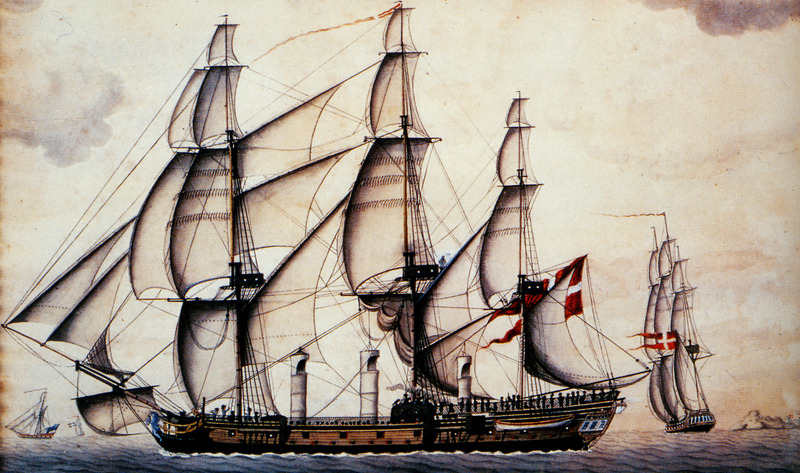Slave Ship Fredensborg II, 1788

Caption, The Fredensborg II heading for St. Croix with a cargo of slaves. This painting, dated 1788, does not depict the Fredensborg described in the Svalesen book, but a later ship of the same name and design. In 1767-68, the Fredensborg I, a Danish slave ship, sailed the triangular trade from Copenhagen to the Gold Coast to the Danish West Indies and return. Note, the three-cylindrical structures hanging above the deck. These slave frigates had some special equipment which distinguished them from ordinary merchant vessels. First, there were the funnels (or so-called 'windsails') with openings in the direction of the wind. They were made of canvas and their function was to funnel fresh air down to the slaves in the hold. . . . The two foreward funnels provided fresh air down to the male slaves, while the funnel closest to the stern sent air to the women and children. Every evening the funnels were hoisted up and the hatches closed and bolted for security reasons (Svalesen, p. 106). Details relating to the voyage of the Fredensborg I can be found in the Svelesen book. (Permission to place this image on website, courtesy of Leif Svalesen and the Danish National Archives; we are grateful to Erik Gobel for his assistance.)
Image Title
Slave Ship Fredensborg II, 1788
RegID
SI-OB-799
Date
1788
Title
Slave Ship Fredensborg II, 1788
Source
Leif Svalesen, The Slave Ship Fredensborg, translated by Pat Shaw and Selena Winsnes (Kingston, Jamaica: Ian Randle publishers, 2000), p. 104; original in The Danish National Archives, Copenhagen.
Language
Danish
Item sets
Slave Ships & the Atlantic Crossing (Middle Passage)
Spatial Coverage
Atlantic
Reproduced In
Leif Svalesen, The Slave Ship Fredensborg, translated by Pat Shaw and Selena Winsnes (Kingston, Jamaica: Ian Randle publishers, 2000), p. 104
Researchers
Handler, Jerome; Tuite, Michael; Randall Ericson; Henry B. Lovejoy Graduate Research Assistants: Tiffany Beebe; Travis May
Identifier
NW0037